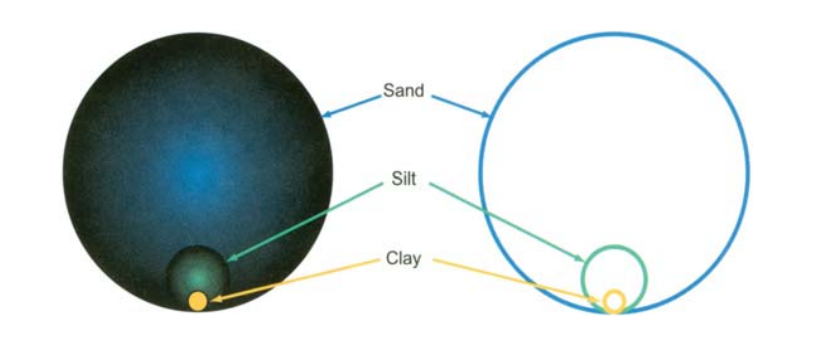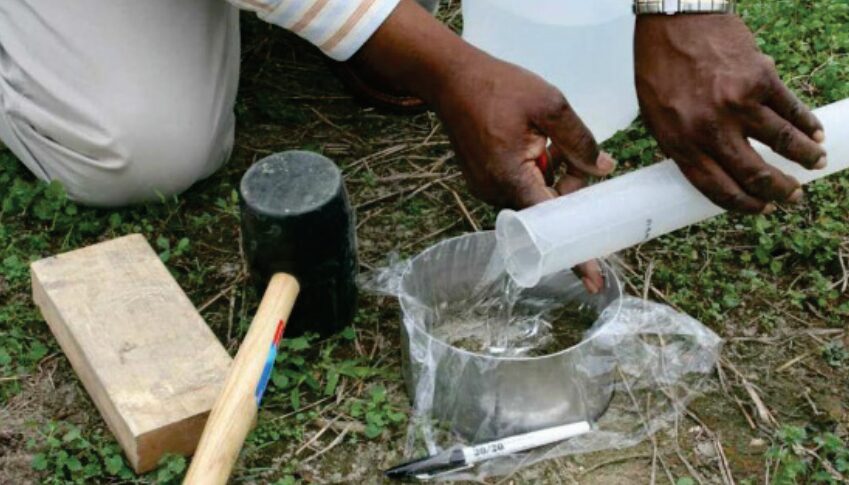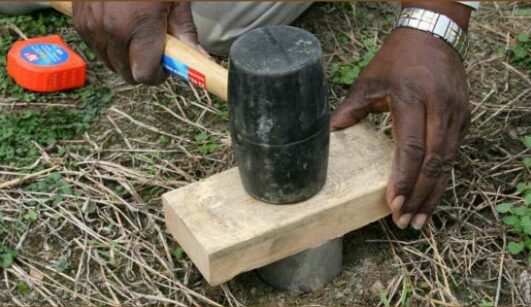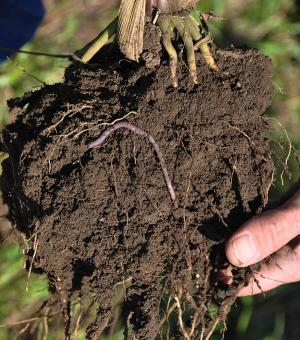Home / Site Design + Construction / Soil Primer + Assessment Toolkit
Highlights
What Is Soil?
Soil is not just “dirt.” Dirt, sand, and gravel are abiotic materials derived from broken-down rocks and minerals. Soil, however, is a dynamic and intricate combination of water, air, minerals, and biological organic matter, composed of both living and decomposing organisms.
The organic matter in this precious layer makes up just 2-10% of the mass of most soils and is highly responsive to external forces and land management strategies.
One teaspoon of healthy soil contains several billion bacteria, fungi, and other microorganisms too small to see without a microscope. It is literally teeming with life.
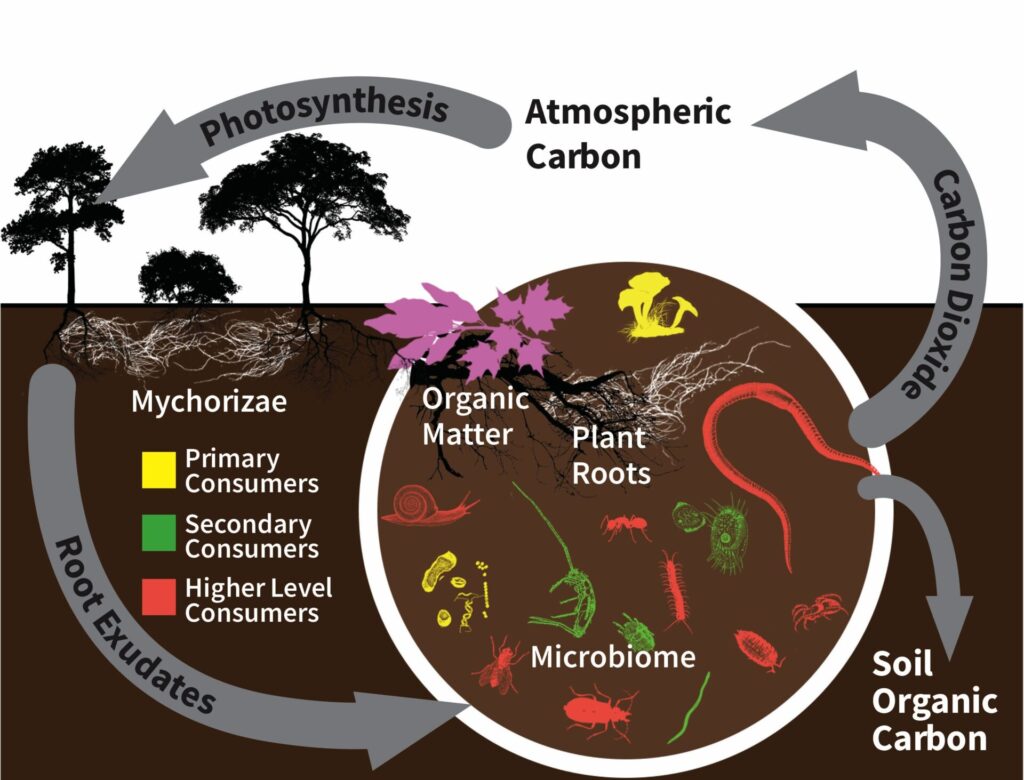
Microorganisms feed on the sugar molecules produced by and released from the roots of photosynthesizing plants. They, in turn, manufacture organic compounds and acids that mine and deliver the exact mineral building blocks required for plant growth. As plant matter increases, the number and variety of soil organisms feeding, colonizing, and consuming these plants also increases, and they accumulate into deeper layers of soil over hundreds and thousands of years.
This co-dependent cycle of nutrients is often referred to as the soil food web. When soil is excavated, left unvegetated, or compacted, the health of the soil food web is compromised, and it is unable to support basic ecosystem functions. Just like in humans, a healthy living soil microbiome is inseparable from a soil’s ability to function physically.
Unlocking the Potential of Soil
More carbon resides in soil than in the atmosphere and all plant life combined; there are 2,500 billion tons of carbon in soil, compared with 800 billion tons in the atmosphere and 560 billion tons in plant and animal life (Ontl & Schulte, 2012). Soil organic carbon makes up 60% of the total global terrestrial carbon stock, storing more than two times as much carbon as above-ground biomass like trees and vegetation (Lal, 2008; Lin et al., 2024). It represents the bulk of opportunity for the future carbon storage and sequestration capacity of Massachusetts living systems.
The biggest reservoirs of soil organic carbon are wetlands and places where biomass is locked into anaerobic sediments. Preserving these natural carbon sinks as much as possible is an important component of reducing the overall carbon footprint of the building sector.
Amazingly, the role that soil biology plays in sequestering and storing carbon in the soil is still being understood, with new research emerging every year. Scientists have recently discovered that SOC is far from stable or persistent in soils. It moves constantly through microbial digestive systems and fluctuates between the soil and the atmosphere (Popkin, 2021). This makes it difficult to quantify the impact of specific soil-building practices. Moreover, the warming climate may increase the rate of microbial carbon digestion and respiration more than initially thought. This has unknown consequences for some of the earth’s biggest terrestrial carbon sinks, particularly soils and wetlands (Soong et al., 2021).
What we do know, however, is that disturbance from agriculture and development has caused the loss of 50 to 70 percent of the original carbon stocks of soils, much of which oxidized into CO2 upon exposure to air (Schwartz, 2014). If we can “turn back the carbon clock” and implement practices that rebuild and support healthy soil microbiomes on degraded soils, we may be able to restore a net negative carbon cycle that draws the equivalent of one-third or more of the world’s current annual CO2 emissions out of the atmosphere (4p1000.Org, 2021; Zomer et al., 2017).
As professionals in design and development fields, we have the responsibility of working with the only element of the built environment—the landscape—that has the potential to provide ongoing carbon sequestration after the completion of an installation.
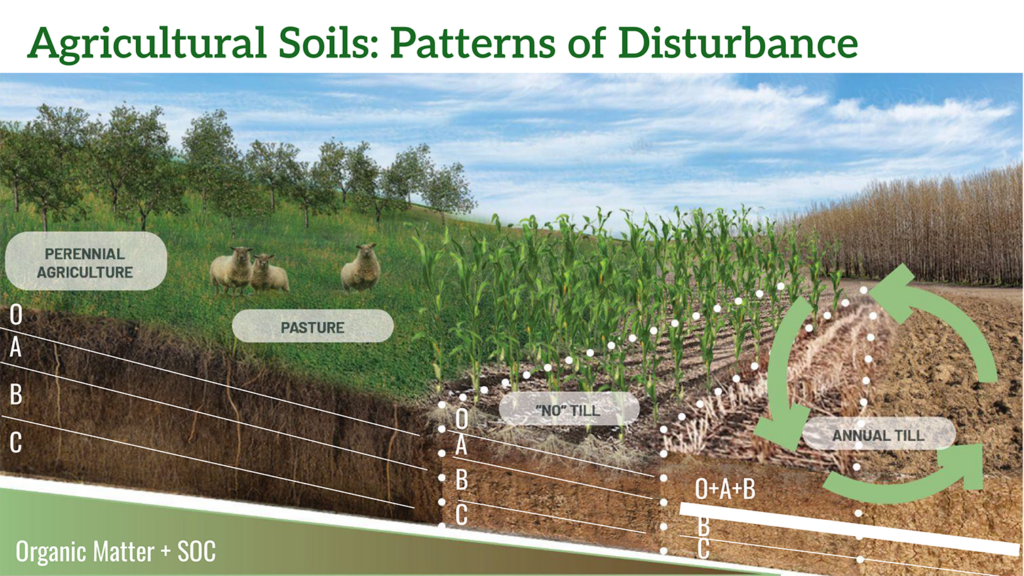
What Makes Soil Healthy?
There is no single recipe for healthy soil! Healthy soil has different characteristics depending on its geographic location, mineral composition, and environmental interactions. Soil health can be assessed by its inherent capacity to function as a dynamic, living system that supports plant and microbial life while maintaining essential environmental and ecological functions.
Healthy Soil Functions
Soils are diverse, dynamic, and difficult to define. Rather than following a universal recipe, soil should be evaluated by what it does when it is healthy. There are five basic characteristics or functions of soil that indicate soil health:
These functions are closely interrelated, and a healthy soil will exhibit all of them to a certain degree. Unfortunately, there is no single test that can reduce the complex interactions of soil into a single proxy of health. Carbon capture and storage, which serves as a cornerstone function of healthy soil, is difficult and expensive to measure directly. Each function must be assessed independently in order to obtain a full picture of the soil’s condition.
Not every landscape can or necessarily ought to maximize every soil function. Permeable pavements need a strong, porous soil that maximizes water infiltration. A green roof must be lightweight and productive. A community garden area will need high levels of nutrient availability, water storage, and biological activity (see Specifying Amended + Blended Soils). While the intended use for each site will drive the prioritization of certain functions over others, a “soil-smart” design will ensure that all five essential soil functions are present in order to maximize the many benefits of healthy, living soil.
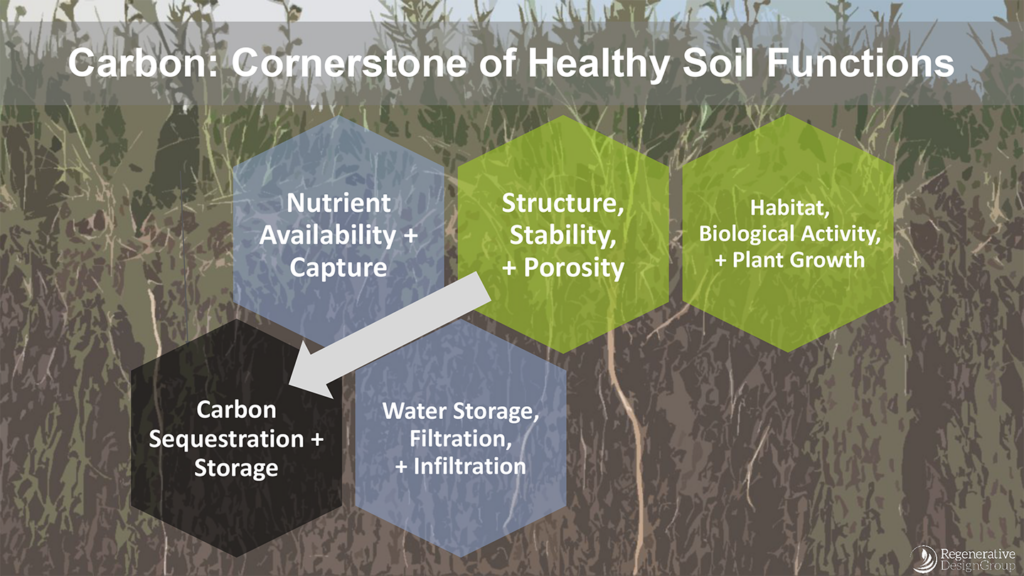
Putting Soil to Work
Protecting and promoting healthy living soil systems is what unlocks the massive carbon storage potential of soil. Soil that is stripped, compacted, and chemically dependent cannot support a healthy microbiome. Without soil organisms, plants are unable to obtain the nutrients they need to thrive; they become nutritionally deficient, more susceptible to pathogens, and more reliant on chemical pesticides and fertilizers. These vulnerabilities can negatively affect the health of humans and ecosystems, as well as create a time and resource sink for landscape management: water becomes a problem to be ‘managed’ rather than a resource, and increasingly destructive natural forces more easily damage costly landscapes.
The design and management decisions we make when building directly impact the health and vitality of the soil. When we better understand soil, we can use the construction process to intervene and produce the best possible soil function outcomes for stormwater management, climate resilience, wetland protection, and carbon capture. When soil is protected, rehabilitated, and managed with practices that support healthy soil biology, it results in greater productivity, carbon sequestration, and resilience to ecological disturbance.
What Builds Soil Health?
- Limited Disturbance
- Permanent Vegetative Cover
- Diverse Soil Food Web
- Remineralization + Nutrient Management
- Protection from Compaction, Contamination, + Conversion
Assessing Soil Functions
The best informed decisions about soil management practices are made by assessing the health and function of soils across different areas of a site prior to construction. Assessing each of the five main soil functions provides the most helpful framework for determining which soils to preserve, amend, or recreate during the construction process. Following construction, the same comprehensive soil assessments should be performed to ensure that the soils are functioning the same, or better, than they were prior to construction.
The table below describes which assessments might be used to evaluate the main soil functions.
Function | Assessment |
|---|---|
Habitat, Biological Activity, + Plant Growth | |
Habitat | Observation: Predominance of native flora and wildlife in various life stages (nests, eggs, larvae, adults, etc.) |
Plant Growth | Observation: Existence and health of above-ground vegetation |
Biological Activity | Observation: Structure, aggregate stability, observed presence of earthworms and/or other soil organisms |
Carbon Sequestration + Storage | |
Storage | Test: SOC % |
Sequestration | N/A (requires specialized equipment, may be cost prohibitive) |
Nutrients Availability + Capture | |
Capture | Observation: Above-ground vegetation, root density and depth |
Availability | Test: Nutrient levels, acidity (pH), cation exchange capacity (CEC) |
Water Storage, Filtration, + Infiltration | |
Storage | Observation: Texture, structure |
Infiltration | Observation + Test: Infiltration, compaction, bulk density |
Filtration | Test: SOM % |
Structure, Stability, + Porosity | |
Structure | Observation + Test: Texture, SOM% |
Stability | Observation + Test: Aggregate stability, texture, compaction |
Porosity | Observation + Test: Infiltration, compaction, bulk density |
What to Assess
In order to get the fullest understanding of the health of soil, a comprehensive evaluation should be conducted that goes beyond the standard soil chemistry test to include physical, biological, and chemical assessments. Most physical and biological assessments can be done on site, whereas chemical tests are most often done in laboratories.
This toolkit covers assessments for ten basic characteristics:
- Physical (In-Field)
- Texture
- Structure
- Porosity, Permeability, and Water Infiltration
- Compaction and Bulk Density
- Aggregate Stability
- Biological (In-Field)
- Soil Organic Matter (SOM)
- Chemical (Laboratory)
- Cation Exchange Capacity
- Soil pH
- Nutrient Levels
- Soil Organic Carbon (SOC)
Soil Assessment “Toolkit”
Learning to recognize the characteristics of healthy or unhealthy soil is a skill that every professional can learn. With a little practice, the basic health of the soil can be assessed without specialized equipment. The following commonly available items are indispensable tools to include in your “toolkit” that can provide key information about the soil both before and after the impacts of construction.
- Spade
- Wire flag (or penetrometer)
- 4 inch diameter drain pipe (8 inches long)
- Half gallon jug of water
- Aluminum soil core ring (4 inches in height and diameter)
- Rubber mallet and a block of wood
- Quart-size mason jars
- Wire mesh or small kitchen strainer
Soil Characteristics
Physical Assessment
Texture
What it is: Soils are composed of mineral particles of sand, silt, and clay of different sizes with organic material that has accumulated in the soil. This composition is influenced by the parent material (i.e. bedrock or deposited materials within which the soil forms), the amount of time since soil formation began, the living beings in the soil, and the geographic location and climate within which the soil is situated. Soil texture is very stable over human timescales in the absence of disturbance.
Soils with relatively low amounts of organic material are referred to as mineral soils. Mineral soil texture classification is determined by the percent breakdown of the different sizes of the mineral soil particles. This ratio is used to interpret soil compaction test results, calculate custom soil specifications and amendment rates, and predict other functions of the soil.
Takeaway: Smaller particles (silt and clay) compact more easily. If a soil can be easily rolled into a “worm” or “ribbon,” then it is extremely vulnerable to compaction from vehicle traffic, and should not be disturbed until conditions are drier. If soils are sandy and loose, they may be vulnerable to erosion and will need additional protection when disturbed.

Structure
What it is: Soil structure is how soil particles and the macropores or spaces between them form structural units. High-functioning soils with well-structured topsoil tend to crumble readily between fingers and exhibit small (<6mm) rounded aggregates, visible pores, a range of pore shapes and sizes that form a continuous network, and numerous well-distributed roots. Soils with more angular, blocky or platey aggregates may be evidence of poorer soil structure and compaction, especially where roots are limited or clustered.
How to Assess: When soils are relatively dry, remove a spadeful of soil and examine it. Is the soil uniform or are there layers? Take a fragment of soil from each layer and see how it crumbles. Does it break easily into smaller pieces that are rounded or does it fall apart in angular clumps? Note the presence of biopores (roots, worm tunnels, etc.) Are plant roots well distributed throughout the soil or concentrated along soil cracks? Are root fibers numerous or lacking?
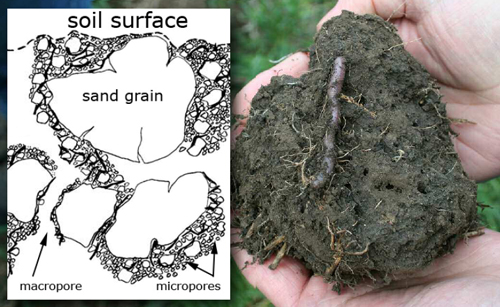
Takeaway: Poorly structured or compacted soils reduce water infiltration and can lead to surface runoff and erosion. Soils with poor structure should be managed carefully during construction to prevent further (irreversible) compaction and degradation. After construction, decompact and amend to fortify the soil biology and improve the soil structure and function.
Porosity, Permeability, + Water Infiltration
What it is: Water infiltration rates provide additional information on soil structure and stability. Improved infiltration of rainfall helps to reduce soil erosion and the loss of nutrients from land to water. Monitoring the rate at which water is absorbed into soil gauges permeability, which indicates how well soils will absorb water during high precipitation events and retain moisture during dry spells.
How to Assess: Drive a short length of pipe 8” long and 4” wide the pipe halfway into the ground using a mallet and fill the pipe to the top with water. Start a stopwatch immediately and record the amount of time it takes for the water to drain completely into the soil. Repeat a few times to determine the steady-state infiltration rate. In well-structured soil, water will drain away faster, typically within 2-5 minutes. Poorly-structured soils with high ratios of clay may take 20 minutes or longer.
Takeaway: Slower infiltration rates indicate higher risk of erosion and damage during high precipitation events. Ifinfiltration time is longer than 5 minutes, include additional stormwater protections during demolition and construction. Permeability can be improved post-construction by decompaction methods, soil amendments rich in organic matter like compost, and deep-rooted vegetation.
Compaction and Bulk Density
What it is: While soil compaction is critical for supporting building infrastructure, it is disastrous for plant and soil biology. One of the most common forms of soil degradation associated with development, soil compaction is at best difficult, costly, and time-consuming to correct, and at worst is irreversible. Compaction impacts root growth and water infiltration and is often measured as a soil’s resistance in pounds per square inch (psi) to penetration from a probe such as a penetrometer or a wire flag.
Bulk density is another indicator of soil compaction. It is calculated as the dry weight of soil divided by its volume. The texture, or composition of silt, sand, and clay in the soil, determines what a healthy bulk density range is for that soil. Lower bulk density allows for better root penetration and water infiltration. Once bulk density exceeds 1.7 g/cm3, roots are no longer able to penetrate through the soil (Morris & Lowery, 1988). A soil core sample taken at various depths in the soil profile and measured (g/cm3) will give you the soil’s bulk density.
How to Assess: To measure topsoil compaction, a simple wire flag can be used. Hold the wire at the flag end and see how far the flag can be pushed into the ground without the wire bending. If the wire can be inserted to a depth of 12 inches or more, it is relatively uncompacted. If the wire begins to bend at a depth of 4 inches or less, the soil is highly compacted. Test multiple spots to avoid stones or roots and compare select areas known to be compacted to less disturbed areas such as fence rows or field edges.
Note that this method does not assess subsoil compaction. A penetrometer should be used for more precise readings. 300 psi is considered preventive to most annual root growth in soils.
For bulk density, use a mallet and wooden block to drive a 4-inch ring into the soil to a depth of 4 inches. Dig around the core and carefully remove it with the undisturbed soil inside. Empty the contents of the ring into a bag and weigh, and calculate bulk density by dividing the mass of the soil (g) by its volume (411.8 cm3). Repeat this sampling method to assess deeper soil horizons (4-8 inches and 8-12 inches).
Density = Mass/Volume = g/cm3 (solids) = g/mL (liquids)Relationship of soil bulk density to root growth based on soil texture (NRCS, 2019)
Soil texture | Ideal bulk density for plant growth | Bulk density that restricts root growth (grams/cm3) |
|---|---|---|
Sand, loamy sand | <1.60 | >1.80 |
Sandy loam, loam | <1.40 | >1.80 |
Sandy clay loam, clay loam | <1.40 | >1.75 |
Silt, silt loam | <1.40 | >1.75 |
Silt loam, silty clay loam | <1.40 | >1.65 |
Sandy clay, silty clay, clay loam | <1.10 | >1.58 |
Clay (>45% clay) | <1.10 | >1.47 |
Takeaway: Soil compaction should not exceed 300 psi in the first 12” of soil. Soil texture will determine the healthy range of bulk density. Compacted soils should be decompacted before the final grading and landscaping. For decompaction methods, see Managing Soils Onsite.
Aggregate Stability
What it is: Aggregate stability measures the movement of soil particles against flowing water, as in the case of heavy rainfall events. Soils that disintegrate quickly have low aggregate stability, whereas soils that retain their structure and allow water to fully penetrate indicate higher stability, which is essential for good soil structure and water retention.
How to Assess: A slake test measures how soil aggregates behave when submerged in water. This test mimics the conditions of short-term exposure to rainwater, as well as long-term exposure during a storm or flood event. To perform the test, select two similar clods of soil from a test hole. Fill two quart-sized jars with water and place a mesh wire “strainer” basket on the top. Place the soil clod into the strainer, ensuring that the soil is completely submerged in water. After 5 minutes, observe how much (if any) of the soil clod remains in the basket. Remove the clod from one jar and break it apart to determine whether the water fully penetrated the inside or if it is still dry. If still intact, leave the other jar to continue dissolving for several hours and see how long it remains.
Takeaway: Soils that have a low aggregate stability are more susceptible to erosion when disturbed and should be protected from stormwater damage during demolition and construction with matts, cover crops, and erosion controls. Post-construction soil building practices such as zero-disturbance, cover cropping, permanent and diverse vegetative cover, and applications of compost and other organic soil amendments can improve aggregate stability
Biological Assessment
Soil Organic Matter
What it is: Soil organic matter (SOM) increases a soil’s ability to sequester carbon and hold on to water, enhances nutrient availability, and supports microbial populations necessary for a functioning soil ecosystem. Soils that are high in organic matter are typically darker in color, have more surface biology and visible soil organisms, contain more plant and insect biopores, resist surface crusting, smell ‘earthy sweet,’ and feel ‘greasy’ to the touch. Wetland soils often have higher levels of organic matter due to the lack of oxygen in saturated and flooded soils, which slows or prevents decomposition.
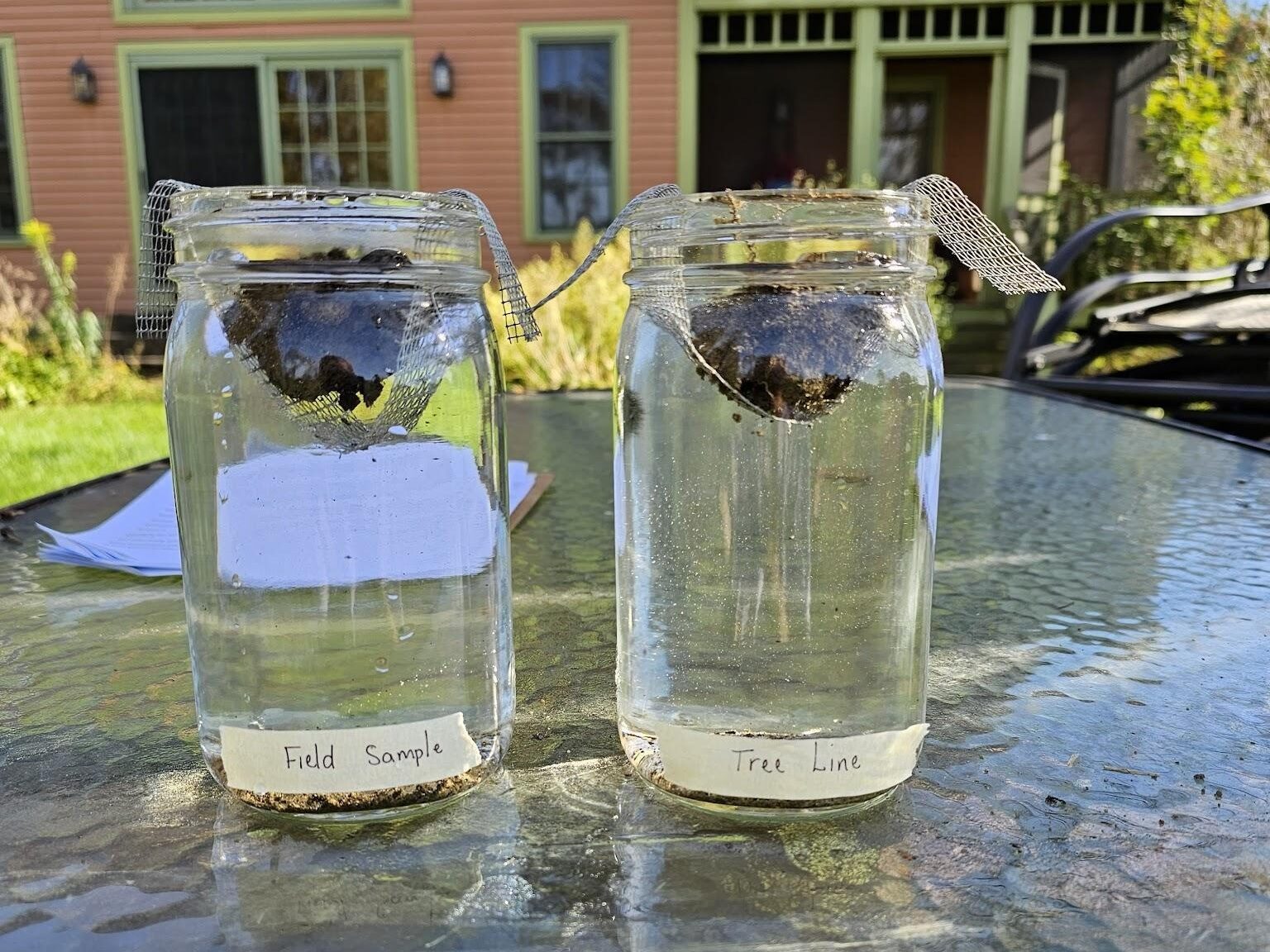
How to Assess: The earthworm test is a time-honored way to assess the organic matter content of soils in the field. Earthworms are large soil microorganisms that indicate the presence of other less visible forms of life. Earthworms are most active during spring and fall and can have a patchy distribution, so multiple tests may be needed for accuracy. To count earthworms, remove a spade full of soil onto a small plastic tarp and record the number of earthworms present. The presence of other insect and root channels or biopores in the soil is a second good indicator of healthy microbiology. A third key indicator is the presence of rhizosheaths, or roots that are covered or tangled in soil aggregates. Rhizosheaths are highly species- and environment-dependent (e.g., brassicas and many broadleaf weeds do not tend to form rhizosheaths). They may indicate the presence of beneficial soil biology colonization as well as glomulin, the glycoprotein or “glue” of arbuscular mycorrhizal fungi that holds soil aggregates together.
Note: Recent studies show that the abundant presence of jumping worms (Amynthas spp.) may lead to substantial changes in soil chemical properties and element cycling in soil. Studies do not, however, show predictable trends for what those changes are, in some cases appearing to increase levels of SOM and others showing decreases (Ferlian et al., 2020). Further research is needed to extrapolate the long-term effects of jumping worms on the soil carbon cycle.
Takeaway: High levels of soil organic matter indicate a high-functioning soil and should be prioritized for protection during construction. Not all soils are naturally high in organic matter. Areas that are disturbed can be amended with compost to increase the soil organic matter.
Chemical Testing
A soil chemistry test is only as good as the sample used to generate test results. Follow good sampling practices from the UMass Soil and Plant Nutrient Testing Laboratory. Aggregate twelve or more representative subsamples to a depth of 6-8” from random spots within the defined area. Do not sample when the soil is wet. Break up any lumps or clods of soil and remove stones, roots, and debris. Once the sample is thoroughly mixed, scoop out approximately one cup of soil, spread it on a clean paper and allow it to air-dry for 24-48 hours. Be sure to label a bag for each sample before submitting to the lab.
Results from a standard soil chemistry test should be used as a rough guide rather than absolute fact. In truth, soil chemistry fluctuates regularly with changes in soil temperature, moisture, land management, and seasonality. The following characteristics can only be assessed by a professional soil lab but will provide key insights into the soil functions that are most impacted by soil chemistry.
Recommendations provided by laboratories are usually tailored to agricultural crops and yields.
Cation Exchange Capacity
Cation exchange capacity (CEC) measures the soil’s ability to hold key nutrients in milliequivalents per 100 grams, or meq/100g. Soil clay minerals and organic matter tend to be negatively charged, thus attracting positively charged ions (cations) of calcium, magnesium, and potassium. Once bonded, these exchangeable macronutrients are less vulnerable to leaching and available for uptake by plant roots. CEC influences soil structure stability, nutrient availability, and pH. Soils high in clay content have higher CEC, whereas soils with lower clay content need larger amounts of organic matter to increase CEC.
Source: UGA Cooperative Extension Circular 1040
Soil Texture | CEC (meq/100g) |
|---|---|
Sand | 1–5 |
Fine Sandy Loam | 5–10 |
Loam | 5–15 |
Clay Loam | 15–30 |
Clay | >30 |
Soil pH
Soil pH refers to the degree of soil acidity or alkalinity, which can greatly impact plant metabolism and biomass yield. Chemically, it is defined as the concentration of hydrogen ions (H+) in the soil. A low pH (below 6.4) indicates that there is an excess of exchangeable hydrogen cations. A high pH (above 7.5) indicates an excess of other cations (calcium, magnesium, and/or potassium). Some nutrients can also become unavailable to plants at certain pH levels, and consistently low pH may indicate heavy metal toxicity. pH levels can be sensitive to soil temperature and moisture and should be monitored periodically.
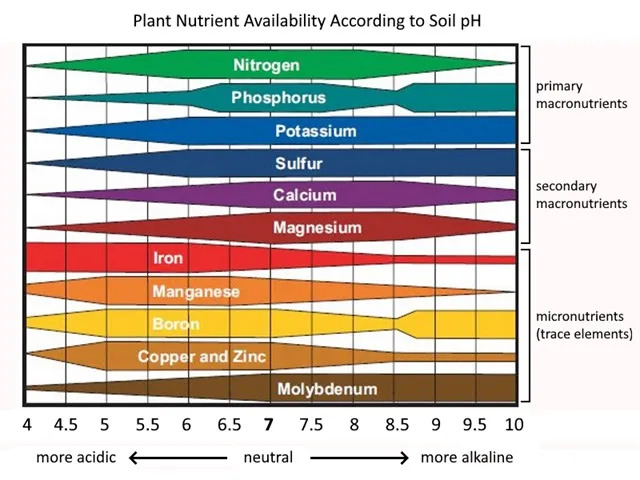
Takeaway: Test the existing soil pH at the onset of a project to determine what the target ecosystem for the site should be. Support a stable soil pH with healthy soil biology and appropriate plant communities.
Nutrient Levels
A chemical analysis provides a snapshot glance at a soil’s nutrient content and availability, which may be used to determine what type of habitat or ecosystem a soil is best suited to support. Once a target ecosystem is determined, identified nutrient deficiencies or excesses may be altered over time with soil amendments.
Conventional chemical fertilizers typically only address the macronutrient (nitrogen, phosphorus and potassium) needs of growing plants, and indiscriminate applications can be counterproductive and disruptive to the soil system. While certain mineral macro and micronutrients can be applied more precisely to correct imbalances, isolating and adjusting single nutrients is extremely difficult to do. Soils, plants, and microbiology are highly complex and codependent, and nutrient applications in general will be much more effective at supporting soil function and productivity when diverse soil biota are present as well.
A chemically balanced soil helps to foster and support a diverse and healthy soil microbiome with the proper ratios of minerals to water and air. In productive soils, four key nutrients should be brought into balance with one another: that ratio is approximately 68% calcium, 12% magnesium, 4% potassium, and 2% sodium. Ultimately, the optimal levels of nutrients must be guided by the target ecosystem, soil texture, and the final design or use of the site.
The following nutrients will be measured in a typical lab analysis:
Nutrient | Role in Soil | Optimal Range (p.p.m.) |
Calcium | Helps bind soil particles into aggregates, which improves soil aeration and drainage. It is a key component of cell walls, lending structural strength to plant tissues. Calcium improves the efficiency of nutrient uptake, can help plants resist diseases, and enables plants to withstand environmental stresses. | 1000–1500 |
Phosphorus | Essential for cell division and development of the growing tip of the plant. It is a crucial nutrient for photosynthesis, but can sometimes bind to other nutrients and become inaccessible to plants. Excess phosphorus in agricultural runoff causes harmful algae and cyanobacterial blooms in rivers and lakes. | 4–14 |
Potassium | Associated with the movement of water, nutrients and carbohydrates in plant tissue. It is involved with enzyme activation and helps regulate the rate of photosynthesis. It also helps regulate the exchange of water vapor, oxygen and carbon dioxide to prevent water and energy losses. | 100–160 |
Magnesium | The core of the chlorophyll molecule in plant tissue. Magnesium is best balanced in a 68:12 ratio with Calcium. (Solomon, 2013) | 50–120 |
Sulfur | A key component of plant metabolism and is required for protein formation, and photosynthesis oil production. | >10 |
Boron | Plays a major role in building cell walls and influences many metabolic processes including root growth. It also helps to leguminous plants with atmospheric nitrogen fixation. | 0.1–0.5 |
Iron | Critical for synthesizing chlorophyll and metabolizing plant enzymes and proteins essential for cellular growth and respiration, and hormone synthesis. Iron is insoluble in alkaline and waterlogged soils. | 2.7–9.4 |
Manganese | Required for photosynthesis, nitrogen metabolism, lignin synthesis, root growth, and activation of many enzymatic systems. High levels of manganese can inhibit iron uptake. | 1.1–6.3 |
Copper | Important for seed set, pollen formation and flowering. | 0.3–0.6 |
Zinc | Drives many metabolic reactions in plants and is important for growth regulation, enzyme activation, and disease resistance. | 1.0–7.6 |
Aluminum | Promotes plant growth, enhances availability and efficient use of phosphorus in plants. Can be phytotoxic in soils with a pH <5.5 | <75 |
Lead | Toxic to plants and humans. Occurs naturally in soils between 15-40 ppm. The US EPA recommends that productive soils fall below 100 ppm and requires screening for residential soils above 200 ppm. | <22 |
Takeaway: Chemically altering soils is challenging and may be counterproductive if done poorly. Before using chemical (synthetic or organic) fertilizers, be sure that the nutrients applied will benefit the whole soil system. Use the results of chemical tests to inform planting plans and establish appropriate vegetation that will not be dependent on annual applications of fertilizers.
Soil Organic Carbon
Soil organic carbon (SOC) is the carbon component in the bodies of living and decaying organisms, and is the most accessible source of food for soil microbes. It makes up approximately 58% of the mass of soil organic matter (SOM) in the topsoil. Organic matter makes up just 2–10% of the total mass of most soils, is dynamic and responsive to land management strategies, and plays a vital role in the healthy function of soils.
Many labs will report SOM on test results using a “loss-on-ignition” test, which involves heating a sample of soil to 450°C to combust the organic matter and weighing the sample before and after to determine the difference. The percent difference is technically SOC, which is then converted to SOM using a conversion factor of 1.72 (derived from 100/58, the average ratio of organic matter to carbon across a variety of soil types).
Organic matter (%) = Soil organic carbon (%) x 1.72Unfortunately, the “loss-on-ignition” test isn’t completely accurate in determining just the amount of carbon in the soil—it can include other non-carbon mineral components that can be dried out. This can overestimate the SOM value. The number also varies depending on soil origin, and is more precise when calculated for forest soils than in sandy soils low in organic matter (DeVos, et al. 2005). There are other ways to measure SOC such as by reducing the combustion temperature, or conducting “dry combustion” through a slower drying and grinding process before heating, but they are typically more time and resource intensive. The use of near-infrared spectroscopy (VIS-NIR) for assessing total soil carbon is still developing though a promising possibility (Bartmiński et al., 2024).
Takeaway: On average, the higher the percentage of soil organic matter in soil, the higher the level of soil organic carbon. The organic carbon in the top six inches of soil is challenging to measure because it is constantly in flux, maintained in living systems, and very vulnerable to changes in soil management strategies. When evaluating a soil chemistry test with a reported percent value of organic matter, keep in mind that this number is only an estimate and should be combined with other more direct observations of soil organic matter health (such as biological indicators of earthworms, biopores, and rhizosheaths).
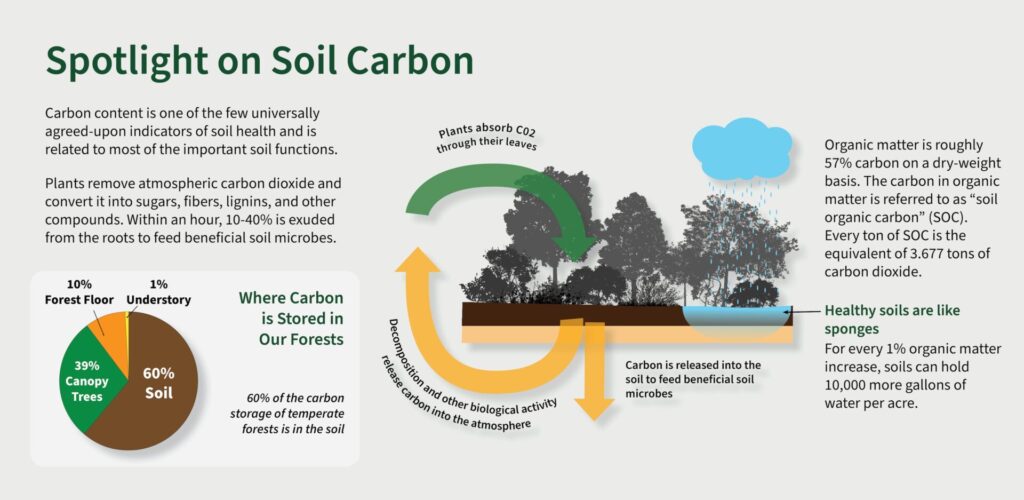
Resources + Tools
Soil Assessment Guides + Toolkits
- NRCS Soil Health Assessment Guides
- Soil Health Indicators | NRCS East National Technology Support Center
- Cropland In-Field Soil Health Assessment Guide | USDA [pdf]
- Soil Quality Test Kit Guide | USDA [pdf]
- Estimating Soil Texture By Hand | DPIRD Government of Western Australia [pdf]
- Soil Assessment Methods | AHDB [pdf]
- Inherent Factors Affecting Bulk Density and Available Water Capacity | USDA [pdf]
- Cornell Soil Health Manual Fact Sheets
- Comprehensive Assessment of Soil Health (CASH) Manual, Ed. 3.2
References
Discover—4 per 1000. (2021, January 21). https://4p1000.org/discover/?lang=en
Ferlian, O., Thakur, M. P., Castañeda González, A., San Emeterio, L. M., Marr, S., da Silva Rocha, B., & Eisenhauer, N. (2020). Soil chemistry turned upside down: A meta-analysis of invasive earthworm effects on soil chemical properties. Ecology, 101(3), e02936. https://doi.org/10.1002/ecy.2936
Lal, R. (2008). Carbon sequestration. Philosophical Transactions of the Royal Society B: Biological Sciences, 363(1492), 815–830. https://doi.org/10.1098/rstb.2007.2185
Lal, R. (2014). Societal value of soil carbon. Journal of Soil and Water Conservation, 69(6), 186A-192A. https://doi.org/10.2489/jswc.69.6.186a
Morris, L. A., & Lowery, R. F. (1988). Influence of Site Preparation on Soil Conditions Affecting Stand Establishment and Tree Growth. Southern Journal of Applied Forestry, 12(3), 170–178. https://doi.org/10.1093/sjaf/12.3.170
NRCS. (2019). Soil Bulk Density (Soil Health Guides for Educators). USDA NRCS. https://nrcs.usda.gov/sites/default/files/2022-10/Soil%20Bulk%20Density%20Moisture%20Aeration.pdf
Ontl, T. A., & Schulte, L. A. (2012). Soil Carbon Storage. Nature Education Knowledge, 3(10), 35.
Popkin, G. (2021, July 27). A Soil-Science Revolution Upends Plans to Fight Climate Change. Quanta Magazine. https://quantamagazine.org/a-soil-science-revolution-upends-plans-to-fight-climate-change-20210727/
Schwartz, J. (2014, March 4). Soil as Carbon Storehouse: New Weapon in Climate Fight? Yale E360. https://e360.yale.edu/features/soil_as_carbon_storehouse_new_weapon_in_climate_fight
Solomon, S. (2013). The Intelligent Gardener. New Society Publishers.
Soong, J. L., Castanha, C., Hicks Pries, C. E., Ofiti, N., Porras, R. C., Riley, W. J., Schmidt, M. W. I., & Torn, M. S. (2021). Five years of whole-soil warming led to loss of subsoil carbon stocks and increased CO2 efflux. Science Advances, 7(21), eabd1343. https://doi.org/10.1126/sciadv.abd1343
Sponagel, H., Eckelmann, W., Grottenthaler, W., Hartmann, K.-J., Hartwich, R., Janetzko, P., Joisten, H., Kühn, D., Sabel, K.-J., & Traidl, R. (2005). Bodenkundliche Kartieranleitung. (German Manual of Soil Mapping, KA5). Bundesanstalt für Geowissenschaften und Rohstoffe, Hannover. https://schweizerbart.de/publications/detail/isbn/9783510959204/Bodenkundliche_Kartieranleitung_5_Aufl?l=EN
Vos, C., Don, A., Prietz, R., Heidkamp, A., & Freibauer, A. (2016). Field-based soil-texture estimates could replace laboratory analysis. Geoderma, 267, 215–219. https://doi.org/10.1016/j.geoderma.2015.12.022
Zomer, R. J., Bossio, D. A., Sommer, R., & Verchot, L. V. (2017). Global Sequestration Potential of Increased Organic Carbon in Cropland Soils. Scientific Reports, 7(1), 15554. https://doi.org/10.1038/s41598-017-15794-8
